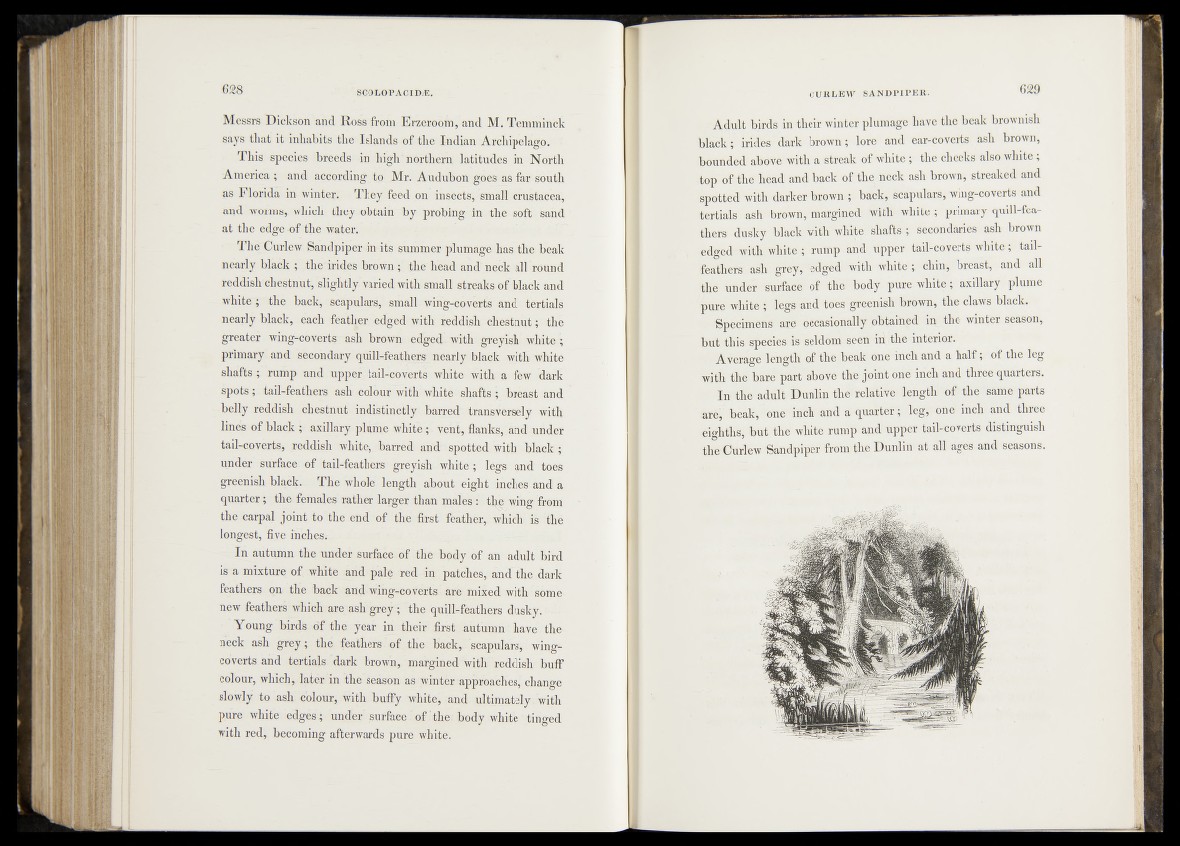
Messrs Dickson and Ross from Erzeroom, and M. Temminck
says that it inhabits the Islands of the Indian Archipelago. '
This species breeds in high'northern- latitudes in North
America; and according tp Mr. Audubon goes as far south
as Florida in-winte^. They feed on insects, small Crustacea,
and worms, which they, obtain by probing in the soft sand
at the edge of the water.
The Curlew Sandpiper-in its summer plumage has the beak
nearly black ; the'irides brown; the head and neck all rOund
reddish chestnut, slightly" varied with small streaks of black and
w h ite r the back, scapulars, small wing-coverts and tertials
nearly black, each feather, edged with reddish chestnut; the
greater wing-coverts ash brown edged with greyish .shite \
primary and secondary quill-feathers nearly black with white
shafts ; rump and uppej. tail-coverts white with a few dark
spots; tail-feathers ash colour with white shafts; breast and
belly reddish ch estn ut in distinctly barred transversely with
lines of black ; axillary plume whiter vent, flanks, and Uhder
tail-coverts, reddish white, barred and spotted with black ;
under surface of tail-feathers greyish white; legs and' toes
greenish black. The whole length, about eight inches and a
quarter; the females rather larger than males-* the wing from
the carpal joint to the end of the first feather, which is thé
longest, five inches*:.. •
In autumn the under surface.of tthe body of an adtilt bird
is: a mixture of white and pale red In patches, and the dark
feathers on- the back and wing^eoverts are mixed with soma
new feathers which are ash grey:; the quilbfeathers dtiskyv^
Young birds öf th^pyèar in their- first autumn: have the
heck ash grey; the feathers - of the back, scapulars;' wing--
coverts and tertials dark brown, margined withT;'reddish buff
Colour, which, later in the season as winter'approaches^ change
slowly to ash colour, with buffy white, and ultimately, with
pure white edges; under surfaee'.ofthe; body white' tinged
with red, becoming afterwards pure white.
Adult birds in their winter plumage have the beak brownish
black; irideS dark brown; lore and ear-coverts ash brown,
bounded above with a streak of white; the cheeks also white;
d-op of the head and back of the neck ash brown, streaked and
Spotted with darker brown ; back, scapulars, wing-coverts and
tertials ash brown, margined tvith white ; primary quill-feathers
dusky black with white shafts*? secondaries ash brown
edged^-with white ; rump and-upper tail-coverts whit#| tail-
feathers ash grey1,hedged with white; 11 chin, "breast, and all
the Under- surface of thedbody ftareiwhite; axillary plume
'pure white ; légs^and Ides greenish' bïëwn, the claws black.
Specimens are occasionally dbtainfid in the winter season,
but this species ïs -seldoid ' seéb in the Interior.
Average lej§$jl£-óf tSë^beak one inch and a half; of the leg
with l ^ b ^ l part a b o ^ th jp m t one inch and three quarters.
In the adtilt D u f ln thJrelapve- length 'of thè- same parts
aré', beak,"o'fl^inch and a quarter; leg, f |p Inch and three-
eighths, but the white rump and fifpei tail-Co^erts - distinguish
the Curlew Sandpiper frongflg Dunlin at all ages and seasons.